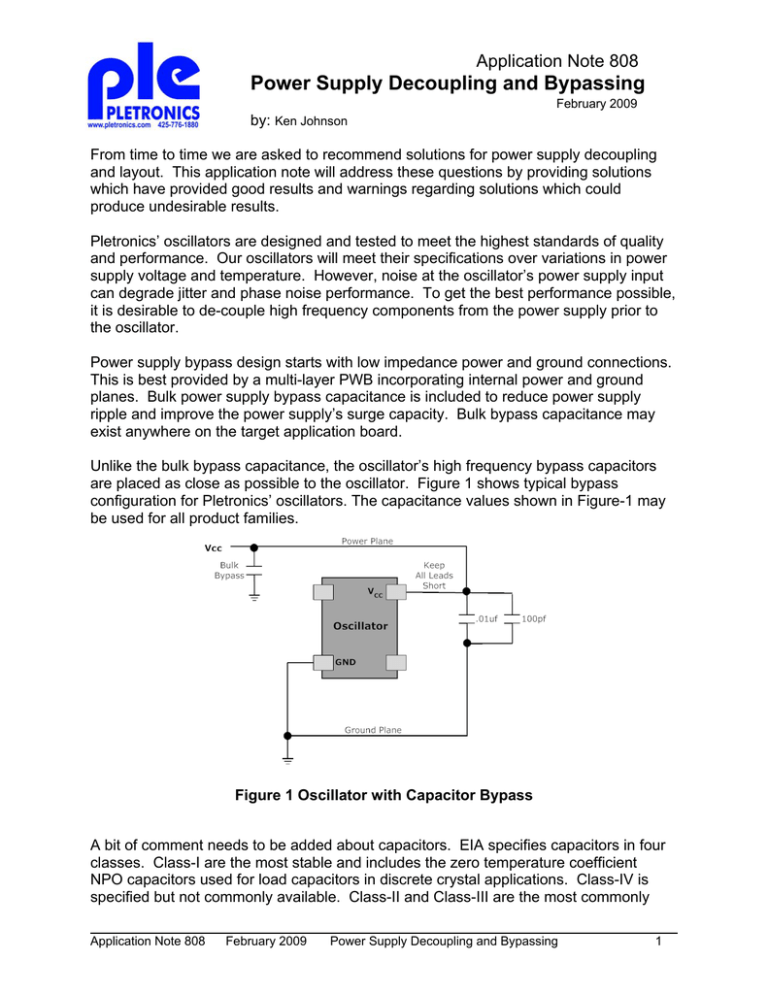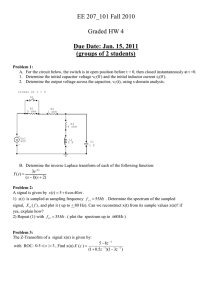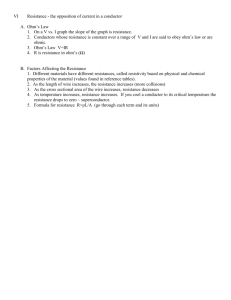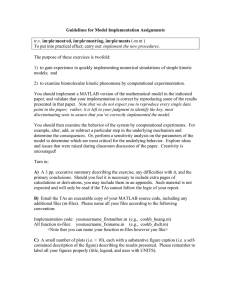Power Supply Decoupling and Bypassing
advertisement

Application Note 808 Power Supply Decoupling and Bypassing February 2009 by: Ken Johnson From time to time we are asked to recommend solutions for power supply decoupling and layout. This application note will address these questions by providing solutions which have provided good results and warnings regarding solutions which could produce undesirable results. Pletronics’ oscillators are designed and tested to meet the highest standards of quality and performance. Our oscillators will meet their specifications over variations in power supply voltage and temperature. However, noise at the oscillator’s power supply input can degrade jitter and phase noise performance. To get the best performance possible, it is desirable to de-couple high frequency components from the power supply prior to the oscillator. Power supply bypass design starts with low impedance power and ground connections. This is best provided by a multi-layer PWB incorporating internal power and ground planes. Bulk power supply bypass capacitance is included to reduce power supply ripple and improve the power supply’s surge capacity. Bulk bypass capacitance may exist anywhere on the target application board. Unlike the bulk bypass capacitance, the oscillator’s high frequency bypass capacitors are placed as close as possible to the oscillator. Figure 1 shows typical bypass configuration for Pletronics’ oscillators. The capacitance values shown in Figure-1 may be used for all product families. Figure 1 Oscillator with Capacitor Bypass A bit of comment needs to be added about capacitors. EIA specifies capacitors in four classes. Class-I are the most stable and includes the zero temperature coefficient NPO capacitors used for load capacitors in discrete crystal applications. Class-IV is specified but not commonly available. Class-II and Class-III are the most commonly Application Note 808 February 2009 Power Supply Decoupling and Bypassing 1 used. For oscillator bypass applications, Pletronics recommends at least X5R capacitors. This class of capacitor is specified from -55ºC to +80ºC, has excellent drift characteristics over this temperature range, excellent high frequency characteristics and good volumetric efficiency. Table 1 summarizes the characteristics of common EIA Class-II and Class-III capacitors. EIA Class EIA Designation Lowest Temperature Highest Temperature Capacitor Drift over Temperature ΙΙ X5R -55oC +85oC ±15% ΙΙ X7R -55oC +125oC ±15% ΙΙΙ Y5V -30oC +85oC +22%/-82% ΙΙΙ Z5U +10oC +85oC +22%/-56% Table 1 Capacitor Characteristics In addition to the bypass capacitor network shown in Figure 1, some designers also insert a series impedance between the oscillator and power supply to create a low pass filter, further isolating the oscillator. The cutoff frequency for this simple filter is given by: Fcutoff ( Hz ) ≈ 1 / ( 2∗ Π∗ Xser∗ Cbypass ) The added impedance, either resistive or inductive, may be in series with the normal capacitive bypass network, or placed between the two bypass capacitors. These connections are shown in Figure 2. Power Plane Vcc Bulk Bypass VCC Oscillator Keep All Leads Short XSER (Alt. 1) X SER (Alt. 2) 100pf .01uf GND Ground Plane Figure 2 Oscillator with Series Impedance Care must be taken any time a resistor is placed in series with the power supply. A surprisingly small value of resistance in series with the power supply is sufficient to Application Note 808 February 2009 Power Supply Decoupling and Bypassing 2 reduce VCC below the oscillator’s VCCmin. Maximum current values for Pletronics oscillators are specified in the data sheets and range from 5uA for some of our 32.768KHz real-time-clock oscillators to 90mA for higher frequency LVPECL oscillators. Table 2 provides maximum resistor values for combinations of ICC, VCC and power supply tolerance. ICC Vcc 1.8V ±5% 2.5V ±5% 2.5V ±10% 3.3V ±10% 5uA 1.8K ohm 25K ohm 50K ohm 66K ohm 25mA 3.6 ohm 5.0 ohm 10 ohm 13.2 ohm 50mA 1.8 ohm 2.5 ohm 5.0 ohm 6.6 ohm 75mA 1.2 ohm 1.7 ohm 3.3 ohm 4.4 ohm 100mA 0.9 ohm 1.3 ohm 2.5 ohm 3.3 ohm Table 2 Maximum Series Resistance Inserting a series ferrite bead between the power supply and the oscillator is also acceptable. The designer should select a low-Q, non-resonant ferrite bead (also called lossy or absorptive beads). A high-Q ferrite bead or inductor could create a resonant tank with the bypass and parasitic capacitance. When selecting a ferrite bead for this application, the bead’s DC resistance must be considered. It is not uncommon for the DC resistance to be one-Ohm or greater. Lead lengths and PWB layout are important considerations for optimal performance. Figure 3 shows close spacings, use of ground planes and parallel capacitor decoupling. Figure 3 Typical PWB layout with decoupling capacitors Application Note 808 February 2009 Power Supply Decoupling and Bypassing 3 IMPORTANT NOTICE Pletronics Incorporated (PLE) reserves the right to make corrections, improvements, modifications and other changes to this product at any time. PLE reserves the right to discontinue any product or service without notice. Customers are responsible for obtaining the latest relevant information before placing orders and should verify that such information is current and complete. All products are sold subject to PLE’s terms and conditions of sale supplied at the time of order acknowledgment. PLE warrants performance of this product to the specifications applicable at the time of sale in accordance with PLE’s limited warranty. Testing and other quality control techniques are used to the extent PLE deems necessary to support this warranty. Except where mandated by specific contractual documents, testing of all parameters of each product is not necessarily performed. PLE assumes no liability for application assistance or customer product design. Customers are responsible for their products and applications using PLE components. To minimize the risks associated with the customer products and applications, customers should provide adequate design and operating safeguards. PLE products are not designed, intended, authorized or warranted to be suitable for use in life support applications, devices or systems or other critical applications that may involve potential risks of death, personal injury or severe property or environmental damage. Inclusion of PLE products in such applications is understood to be fully at the risk of the customer. Use of PLE products in such applications requires the written approval of an appropriate PLE officer. Questions concerning potential risk applications should be directed to PLE. PLE does not warrant or represent that any license, either express or implied, is granted under any PLE patent right, copyright, artwork or other intellectual property right relating to any combination, machine or process which PLE product or services are used. Information published by PLE regarding third-party products or services does not constitute a license from PLE to use such products or services or a warranty or endorsement thereof. Use of such information may require a license from a third party under the patents or other intellectual property of the third party, or a license from PLE under the patents or other intellectual property of PLE. Reproduction of information in PLE data sheets or web site is permissible only if the reproduction is without alteration and is accompanied by associated warranties, conditions, limitations and notices. Reproduction of this information with alteration is an unfair and deceptive business practice. PLE is not responsible or liable for such altered documents. Resale of PLE products or services with statements different from or beyond the parameters stated by PLE for that product or service voids all express and implied warranties for the associated PLE product or service and is an unfair or deceptive business practice. PLE is not responsible for any such statements. Contacting Pletronics Inc. Pletronics Inc. 19013 36th Ave. West Lynnwood, WA 98036-5761 USA Tel: 425-776-1880 Fax: 425-776-2760 E-mail: ple-sales@pletronics.com URL: www.pletronics.com Copyright © 2009 Pletronics Inc. Application Note 808 February 2009 Power Supply Decoupling and Bypassing 4




